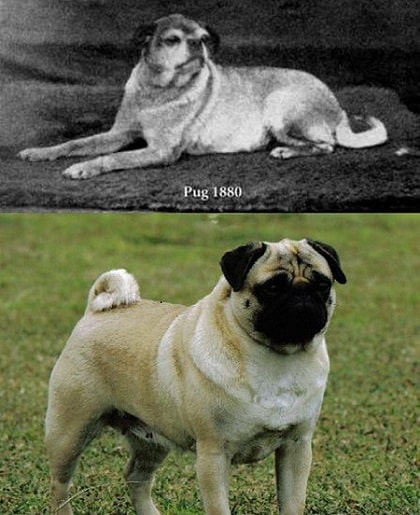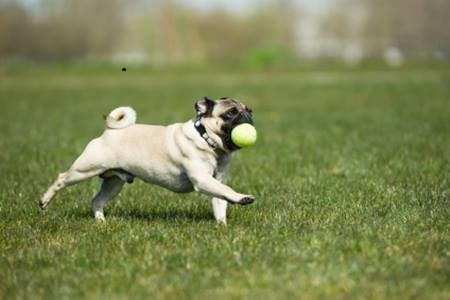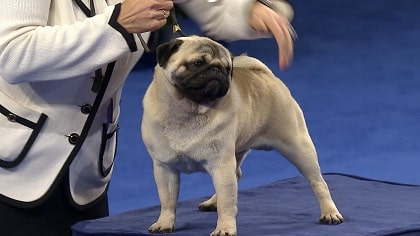The Pug is rightly called “A lot of dog in a small space”, for his admirable personality and a compact size. These playful little dogs love their families a little too much.
They’re very affectionate and love their humans. These small dogs has a lot to give and expect the same in return. Small but sturdy, the pugs have a compact square body with well-developed muscles.
Pug Breed Overview

| Group: | Toy |
| Size: | Small (14-18 pounds)) |
| Lifespan: | 12 to 15 years |
| Best Suited For: | Families |
| Temperament: | Docile, Clever, Stubborn, Playful, Loving |
| Exercise Needs: | Moderate |
| Drooling Potential: | Low |
| Grooming Needs: | Low |
| Similar Breeds: | French bulldog, English Mastiff, Pekingese, Bulldog |
1. Basic Features
Pugs are small but muscular and sturdy dog breeds which belong to the toy breed. They are particularly well known for their comical face, with deep wrinkles around big, dark eyes and a flat round face. Pugs love humans and are very loveable. They are very playful and are always ready for games.
Moreover, this little one tends to develop anxiety if separated from its human for long. They love being around families and people. Pugs are great with other dogs, cats, and children. Moreover, they are bigger than most of the Toy dog breeds.
2. Pug Origin

The early history of the Pug breed is not known in great detail. Pugs are believed to be originated in China, dating back to the Han dynasty. They can be traced back to some 2,000 years.
However, some historians believe they are related to the Tibetan Mastiff. The emperors of ancient China had a preference for toy dogs with flat faces. These dogs were prized by the Emperors of China and lived in luxurious accommodations. They were sometimes even being guarded by soldiers.
Surprisingly, Pugs were developed as refined pets of the emperor, his family, and members of the imperial court. At that time, the pugs could only be acquired as a gift.
Later, the Pugs started spreading to other parts of Asia. They were even kept as pets in the Buddhist monasteries. Since that time itself, the breed has kept its devotion to its owners.
3. The Personality of Pug
Pugs are ideal house dogs. Pugs stay happy with their families and enjoy their food and play.
They are great companions and expect great affection in return.
In addition to that, Pugs require socialization and exposure while they’re growing up to ensure a healthy personality. They are rarely aggressive but very strong-willed.
Pugs are very sensitive to their environment and those around them. They are also known to be comical, not just for their looks but also for its behavior.
4. Pug Behavior
Pugs are said to be very docile and quiet but can also be the opposite at times. They are very sensitive to their owner’s mood and are ever ready to please them. They thrive on human companionship and their moods can hence change according to their master’s.
Pugs have seen craving attention and love from their owners all the time. They usually stay calm but can get a quick burst of energy at times.
Pugs often develop the frowned upon the behavior of begging for food. This is due to the fact that Pugs are food motivated. Pugs are typically a vocal dog breed, which includes barking, yapping, grunting, snorting, and other noises.
5. Exercise Requirements

Pugs are considered lazy and would love to spend most of their time napping. Most importantly, they love their naps as much as they love their food and this can lead to obesity problems in pugs. However, with proper exercise, this can be avoided. Pugs require a moderate amount of exercise to keep fit.
Pugs are playful and lively too and love their walks as much. With regular walks and play time, it is possible to keep the dog fit. It is, however, necessary to note that they are sensitive to hot weather and should exercise indoors or when the weather is pleasant.
6. Diet Needs
Pugs require good high-quality dog food. The meals that your Pug consumes will directly influence his health.
They love food and treats which in large amounts can cause obesity.
So it is very important to check the calorie consumption and the amount of food consumed daily. A grain-free diet is also recommended in Pugs in order to avoid skin problems and other allergies.
7. Trainability

As Pugs love their humans and are always willing to please them, they train quite easily. However, they are very sensitive so shouldn’t be treated or trained harshly. Early socialization training is also strongly recommended.
Pugs are also very headstrong and training should be made fun for them. It is also recommended that training is started at an early age.
Rewards can be used to teach your pug to focus on you as they tend to be distracted easily. If left alone, pugs may have separation anxiety and become destructive. Training your pug to stay in a comfortable small area when you aren’t home can be helpful.
8. Common Health Problems
Pugs are prone to different health problems. Their eyes are one of their vulnerable spots. Corneal ulcers and dry eye are known to be a common problem in the pugs.
Breathing problems are also very common among pugs due to their flat face and nose. They don’t do very well in hot and humid climates.
Regular vet visits and evaluations are highly recommended.
9. Who should Adopt a Pug?
Pugs are perfect family pets. They are very gentle and affectionate. Pugs love their families and are great with children. They mix up with other dogs and cats easily too.
Pugs are best suited for families who can give ample time to their dog. Pugs tend to be dependent on their families and love to spend time with them.
However, they may develop anxiety if separated from their owners. Thus, families who have a lot of time to spend with their pooch should be perfect Pug parents.
